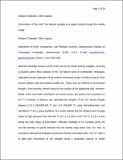| dc.contributor.author | Chatterjee, Nilanjan | |
| dc.contributor.author | Jagoutz, Oliver E | |
| dc.date.accessioned | 2017-03-09T20:11:42Z | |
| dc.date.available | 2017-03-09T20:11:42Z | |
| dc.date.issued | 2015-01 | |
| dc.date.submitted | 2014-03 | |
| dc.identifier.issn | 0010-7999 | |
| dc.identifier.issn | 1432-0967 | |
| dc.identifier.uri | http://hdl.handle.net/1721.1/107266 | |
| dc.description.abstract | Ultrahigh-pressure (UHP) rocks such as the coesite-bearing eclogites, occurring as boudins within felsic gneisses of the Tso Morari dome in northwestern Himalayas, originated through subduction of the northern continental margin of India during its early Eocene collision with the Kohistan–Ladakh arc. These rocks are believed to be exhumed through a low-viscosity channel along the top surface of the subducting slab. However, details of the exhumation mechanism are poorly known. We present new constraints on the P–T evolution of hydrous and carbonate-rich samples of the Tso Morari eclogite between 2.2–2.3 GPa/400–425 °C and ~0.4 GPa/450 °C using thermobarometry and calculated P–T– M[subscript CO[subscript 2]] phase equilibria. Our results indicate that the eclogites were strongly heated at high pressures from 400–425 °C at 2.2–2.3 GPa to 670–720 °C at 1.8–1.9 GPa during the early stages of exhumation. Diffusion modeling of Ca variation across the core–rim interface of garnet indicates that the heating stage lasted only <0.1 Myr, in accordance with geochronological constraints and fast exhumation rates. Our P–T path is at odds with exhumation of the eclogites along a subduction channel as model calculations indicate that the intermediate P–T conditions of 1.8–1.9 GPa/670–720 °C are not achieved along the subducting slab. Instead, the constrained P–T conditions are consistent with heating within the mantle wedge overlying the subducting slab. Therefore, we conclude that the Tso Morari eclogites were possibly exhumed as part of a low-density, felsic diapir rising through the mantle wedge. Based on low viscosity values (1.7 × 10[superscript 19]–5.0 × 10[superscript 19] Pa s) of mantle wedges associated with modern subduction zones, the calculated exhumation rate for the Tso Morari eclogite is extremely fast (29–147 mm/yr) and at par with that constrained for other northwestern Himalayan UHP rocks. | en_US |
| dc.description.sponsorship | National Science Foundation (U.S.) (NSF EAR 0910644) | en_US |
| dc.publisher | Springer Berlin Heidelberg | en_US |
| dc.relation.isversionof | http://dx.doi.org/10.1007/s00410-014-1099-y | en_US |
| dc.rights | Creative Commons Attribution-Noncommercial-Share Alike | en_US |
| dc.rights.uri | http://creativecommons.org/licenses/by-nc-sa/4.0/ | en_US |
| dc.source | Springer Berlin Heidelberg | en_US |
| dc.title | Exhumation of the UHP Tso Morari eclogite as a diapir rising through the mantle wedge | en_US |
| dc.type | Article | en_US |
| dc.identifier.citation | Chatterjee, Nilanjan, and Oliver Jagoutz. “Exhumation of the UHP Tso Morari Eclogite as a Diapir Rising through the Mantle Wedge.” Contributions to Mineralogy and Petrology 169.1 (2015): n. pag. | en_US |
| dc.contributor.department | Massachusetts Institute of Technology. Department of Earth, Atmospheric, and Planetary Sciences | en_US |
| dc.contributor.mitauthor | Chatterjee, Nilanjan | |
| dc.contributor.mitauthor | Jagoutz, Oliver E | |
| dc.relation.journal | Contributions to Mineralogy and Petrology | en_US |
| dc.eprint.version | Author's final manuscript | en_US |
| dc.type.uri | http://purl.org/eprint/type/JournalArticle | en_US |
| eprint.status | http://purl.org/eprint/status/PeerReviewed | en_US |
| dc.date.updated | 2016-05-23T12:10:27Z | |
| dc.language.rfc3066 | en | |
| dc.rights.holder | Springer-Verlag Berlin Heidelberg | |
| dspace.orderedauthors | Chatterjee, Nilanjan; Jagoutz, Oliver | en_US |
| dspace.embargo.terms | N | en |
| dc.identifier.orcid | https://orcid.org/0000-0003-2402-3736 | |
| mit.license | OPEN_ACCESS_POLICY | en_US |
